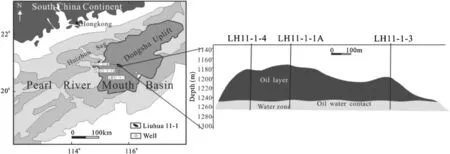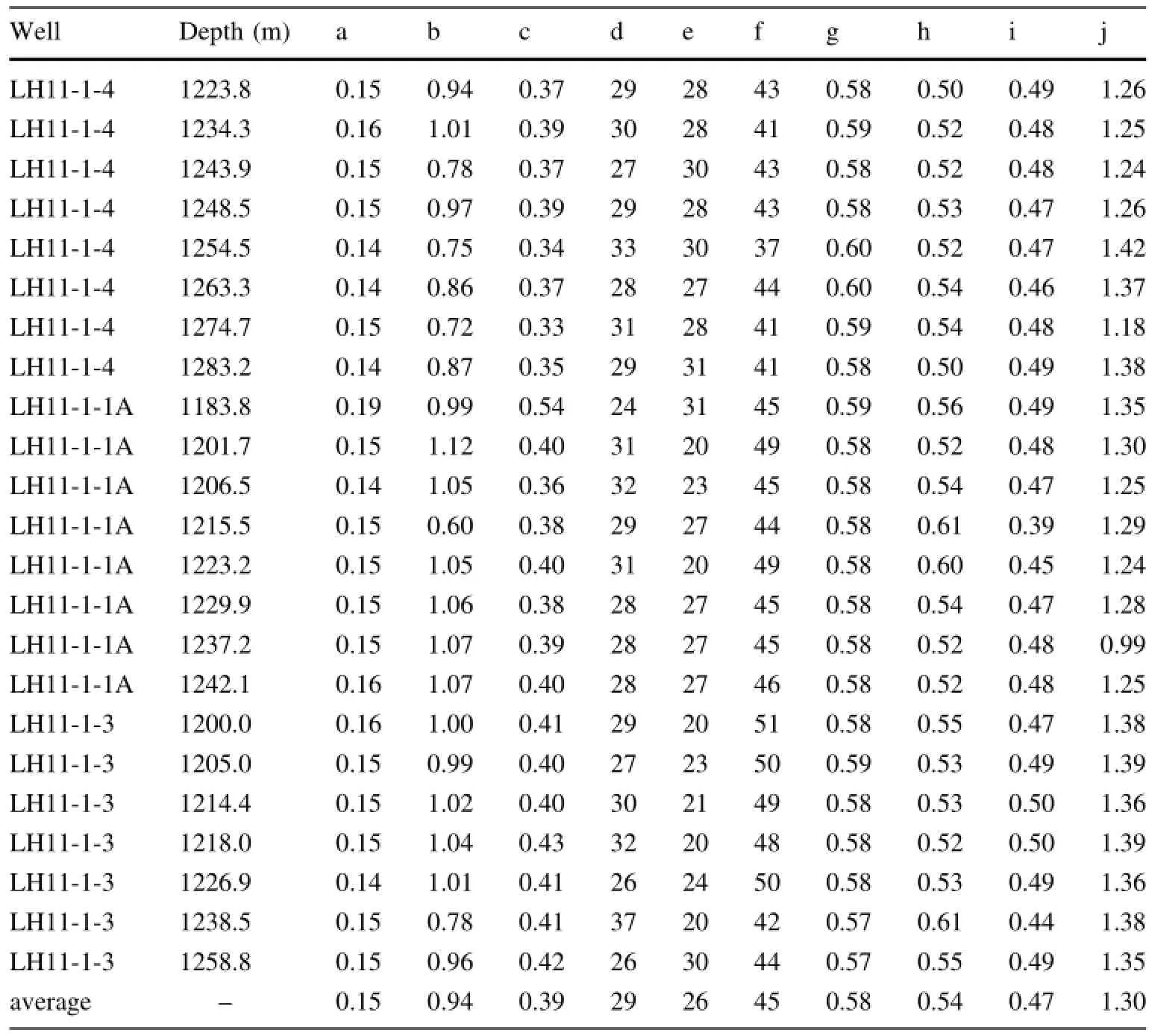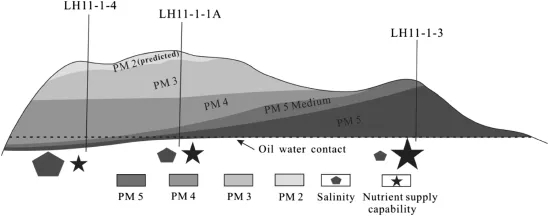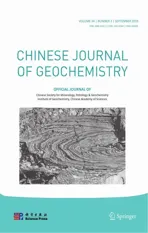The controls on the composition of biodegraded oils in the Liuhua11-1 Oilfeld,Pearl River Mouth Basin,South China Sea
2015-01-17JiangKaixiHeWenxiangXiangNianPengLiHanChangchunGuoQingzheng
Jiang Kaixi·He Wenxiang·Xiang Nian·Peng Li·Han Changchun· Guo Qingzheng
The controls on the composition of biodegraded oils in the Liuhua11-1 Oilfeld,Pearl River Mouth Basin,South China Sea
Jiang Kaixi1·He Wenxiang2·Xiang Nian1·Peng Li3·Han Changchun4· Guo Qingzheng1
(1)The geochemical characteristics of extracted oils in three oil columns from the Liuhua11-1 Oilfeld in the PearlRiverMouthBasinofSouthChinaSeawereanalyzedin detail.The results show that the oil of Liuhua 11-1 Oilfeld is generated from a single source rock,and belongs to maturate oil and their maturities have little difference.(2)The characteristics of saturated hydrocarbon gas chromatography, bulk composition,concentrations of biomarkers and gas chromatography–mass spectrometry of saturated hydrocarbon indicate that all samples studied were biodegraded,and the maximal level of biodegradation is less than PM level 6. (3)Bulk composition and the degree of biodegradation presentedexcellentgradientvariationsintheoilcolumns,andthe highest degradation rates occurred at or near the oil–water contact(OWC).Thekey biomarkers of steranes and terpanes and maturity parameters of saturated hydrocarbon were not affected by degradation,which means that they are stable in slight to moderately biodegraded oils.Across the oilfeld,the degreeofbiodegradationofLH11-1-3washigherthanthatof LH11-1-1A and LH 11-1-4 in general.(4)We infer that the strong hydrodynamic conditions(tectonic control)and high reservoirtemperatures(50–65°C)aretheprimarycontrollersofthedegreeofoilbiodegradationintheLiuhua11-1Oilfeld and the late hydrocarbon accumulation may also have an important effect.The bulk composition and degree of biodegradation with excellent gradient variations in the oil columns were obviously controlled by the vertical distance fromitsinsituplacetoOWC.Thehighestsupplyofnutrientat the OWC results in high abundance of microorganisms and the highest degradation rate.Andthe lateral variationinlevel of biodegradation across the oil reservoir may be mainly control by the salinity of bottom water,the supply of nutrient and the energy of the bottom water.
Biodegradation·Geochemical characteristics·Controllers·Liuhua 11-1 Oilfeld· Pearl River Mouth Basin
1 Introduction
Biodegradation of crude oil and natural gas in the reservoir is an important alteration process during the history of hydrocarbon migration and accumulation,which contributes to changes in hydrocarbon composition(Peters and Moldowan 1993;Peters et al.2005;Head et al.2003).In recent years,the advanced molecular biological techniques have been used to discover the mechanisms of aerobic and anaerobic degradation of hydrocarbons to establish the prediction model of biodegradation in reservoir(Jones et al.2007).During the process of oilfeld exploration and development,the model of biodegradation can be used to predict the degree of biodegradation in the reservoir to reduce the exploration risk and optimize the production (Hongjing et al.2004;Chunming et al.2007;Larter et al. 2008).The degree and rate of the biodegradation is controlled by oil composition,reservoir temperature(<80°C),reservoir property,water salinity,the relative volumes of oil column to water column,the oil–water contact(OWC) area,nutrients(nitrogen,potassium,phosphorus,etc.)and history of hydrocarbon accumulation(Wenger et al.2002; Larter et al.2006).
To ensure more accurate assessment of fuid heterogeneity in heavy oil reservoir,accurate predictions on the degree of biodegradation,oil density and viscosity are needed(Larter et al.2003,2006;Huang et al.2004;Bennett et al.2013).So,further researches on the rules of biodegradation in the oil reservoir are needed.Since the oil reservoir formation is very complicated by natural geological and geochemical process in sedimentary basin,and factors infuencing the biodegradation are multitudinous, the control factors and details of the biodegradation process are still poorly understood.Liuhua11-1 Oilfeld is a massive reef limestone reservoir located at Dongsha Uplift, Pearl River Mouth Basin(PRMB).It has one OWC with the simple trap shape,which is an ideal natural laboratory for studying the controls on the composition of biodegraded oils.This paper,with three coring wells LH11-1-4, LH11-1-1A and LH11-1-3 as the research objects,adopted the analyses of bulk compositions,gas chromatography (GC)and gas chromatography–mass spectrometry(GC–MS)of the extracted oils.The spatial distribution characteristics of biodegradation degrees in the oil reservoir had been studied,and the controls on the composition of biodegraded oil were investigated in detail.
2 Geological setting
The Liuhua 11-1 Oilfeld is located at the carbonate platform formed on Dongsha Uplift in the PRMB(Fig.1).The PRMB is a typical passive margin basin in the South China Sea.The Huizhou Sag is the most important petroleumgenerating center in northern depression of PRMB.The Eocene Wenchang Formation and Oligocene Enping Formation were the two sets of petroleum source rocks in Huizhou Sag.The Wenchang Formation was deposited in the middle-deep water lakes.The average organic carbon (TOC)value in mudstone of Wenchang Formation was 2.36%.The organic matters were composed of Type I–II kerogens.A transition from lacustrine deposits to swampfuvial and fuvial deposits is present in the Enping Formation.The organic-rich mud and coals were deposited and were composed of Type I–II kerogens,with average TOC value of 1.45%.The Liuhua 11-1 Oilfeld was discovered in 1987 in 310 m water depth.It is 200 km southeast of Hong Kong and covers an area of 16.4 km2. The crude oil was from 75 m of productive Lower Miocene Zhujiang carbonate(Tyrrell and Christian 1992).The OWC is at the depth of 1247 m.The Liuhua 11-1 Oilfeld is a reef limestone reservoir,and has excellent porosity and permeability.The average reservoir porosity is 22.4%,and the average reservoir permeability is 652×10−3μm2(Dali et al.2005;Junzhang et al.2007).
3 Samples and methods
3.1 Sampling
The core samples were collected from LH11-1-4,LH11-1-1A and LH11-1-3,where cores were collected from the oil column,and into the supporting aquifer under the oil column.The distribution of wells is showed on Fig.1.The core samples were kept under frozen conditions during shipping and subsequent storage period.

Fig.1 Structure framework of Pearl River Mouth Basin and the cross-section of Liuhua11-1 Oilfeld
3.2 Experimental methods
The core samples were crushed to 100 meshes and extracted for72 h with dichloromethane by Soxhlet extraction.Asphaltenes in the core extracts were removed by n-hexane precipitation.The de-asphaltened core extracts were separated into saturated and aromatic hydrocarbon fractions by silica gel and alumina column chromatography.Bulk fraction characterization of the extracted oils was carried out using an Iatroscan method.GC analyses of the extracted oils were performed on an HP6890N system equipped with an HP-PONA fused silica capillary column (50 m×0.20 mm×0.3 μm)by using N2as carrier gas at 1.0 ml/min.The over temperature was programmed at 35° C for 10 min,then ramped to 300°C at 4°C/min,and fnally held for 50 min at 300°C.The injection and detector temperature was 300°C.All extracted oils analyzed in this study suffered biodegradation at different levels. The feature of biodegraded extracted oils is the“baseline hump”in gas chromatograms(Fig.2).
GC–MS was conducted on the saturated fractions by using an Agilent 7890-5975c system equipped with an HP-5 ms capillary column(60 m×0.25 mm×0.25 m).The temperature program for saturated hydrocarbons was 50°C for 1 min,50–120°C at 20°C/min,120–250°C at 4°C/ min,250–310°C at 3°C/min,and fnally held for 30 min at 310°C.The temperature of the injector was 300°C. Helium was used as carrier gas at a fow rate of 1 ml/min. The scan range was from 50 to 550 Da by using full scan and multiple ion detection(MID)at 70 eV.And 5α-androstanes was used as an internal standard for the saturated hydrocarbons quantitative analysis.
4 Results
4.1 Oil source and thermal maturity
The mature oils have been found in Huizhou Sag and its neighboring area can be classifed into three types by their geochemical characteristics(Shuichang et al.2004;Junzhang et al.2007;Youchuan et al.2009).Type A oil,with high content of C304-methylsteranes and low content of bicadinanes,was derived from the middle-deep lacustrine source rock in Wenchang Formation.Type B oil,with abundant bicadinanes and absent C304-methylsteranes,was derived from source rock of Enping Formation.Type C oil was the mixed oil of Type A and Type B,with high content of C304-methylsteranes and bicadinanes.The oils of Liuhua11-1 Oilfeld sourced from Huizhou Sag and migrated updip along the Hui-Liu Structure Ridge through the marine sandstone carriers within the Zhuhai Formation to accumulate in the trap of Liuhua 11-1carbonate platform (Tyrrell and Christian 1992).The detailed study of geochemical characteristics of extracted oils leads to a deeper understanding of the origin of oils in Liuhua 11-1 Oilfeld.
Since the distribution of terpanes and steranes appears to be unaffected by the degradation process that affected the investigated oils,these biomarkers are used to assess the characteristics of the source rock that generates theses oils. In the case of Liuhua 11-1,oleanane in the extracted oils is much lower than C30hopane and the oleanane/C30hopane ratio is between 0.14 and 0.19.This ratio suggests the algal source of the Liuhua11-1 oils and the absence of higher plant or terrestrial input.The abundance of C304-methylsteranes has been used as an indicator of oil types.The higher relative amount of C304-methylsteranes has been observed in the Liuhua 11-1 extracted oils.The C304-methylsteranes/C29steranes ratio shows high value between 0.60 and 1.12.The C27–C29steranes distributed in“V”shape,which is the common feature of A Type oil.The Liuhua 11-1 extracted oils had low content of bicadinanes. The bicadinane chemical(W)is extremely low and the bicadinane chemical(T)is much lower than C30hopane. T/C30hopane ratio is between 0.33 and 0.54(Fig.3; Table1).The relative amount of C27–C29steranes can be used to determine the source rock differences.It has now been found that the presence of C29steranes does not necessarily mean an input of higher plant material,as C29steranes can also have an algal source(Peters and Moldowan 1993).The slightly higher relative amount of C29steranes in the Liuhua 11-1 extracted oils would be expected for organic matter of lacustrine origin(Fig.4). The uniform distribution patterns in the Liuhua 11-1 extracted oils are indicative of their similarity in terms of organic matter type and paleoenvironment of deposition.The mature parameters of C31hopaneαβ22S/(22S+22R) with an average value of 0.58,C29steranes20S/20(S+R) with an average value of 0.54,C29steranesββ/(αα+ββ)with an average value of 0.47 and Ts/Tm with an average value of 1.30 are indicative of the mature oil(Seifert and Moldwan 1986;Peters and Moldowan 1993;Peters et al. 2005)(Table 1).According to those mentioned above,the oils of Liuhua 11-1 are typical A Type mature oil and derived from the middle-deep lacustrine source rock in Wenchang Formation in Huizhou Sag.

Fig.2 Gas chromatograms of extracted oils from reservoir cores from the Liuhua11-1 Oilfeld

Fig.3 Typical biomarker characteristic of saturated hydrocarbon for extracted oil from the Liuhua11-1 Oilfeld(a case from LH11-1-4)

Table 1 Biomarker parameters of saturated hydrocarbons for extracted oils from the Liuhua11-1 Oilfeld
4.2 Biodegradation level
The observed depletion of n-alkanes and acyclic isoprenoid alkanes(phytane and pristane)indicated that all extracted oils studied were biodegraded(Fig.5).The analysis of the fractions derived from the extracted oils did not reveal a preservation of 25-norhopanes.Therefore,all extracted oils studied were biodegraded to PM level<6 on the scale proposed by Peters and Moldowan(1993).Through comprehensive analysisofn-alkanes,acyclic isoprenoidalkanes,monocyclic alkanes etc.,the biodegradation levels of extracted oils from LH11-1-4,LH11-1-1A and LH11-1-3 havebeendividedintofvebiodegradationlevels:PM3,PM4 medium,PM4 serious,PM5 medium and PM5 serious.

Fig.4 Ternary diagram of the relative abundance of C27αααR, C28αααR and C29αααR regular steranes in extracted oils from the Liuhua11-1 Oilfeld
4.3 Concentration variation in biodegraded oil columns
The buck composition data(saturated hydrocarbons,aromatic hydrocarbons,non-hydrocarbon and asphaltenes) acquired by Iatroscan analysis enabled an assessment of the compositional changes occurring within each oil column. Variations in the abundance of residual oil,the saturated hydrocarbon fraction and of the non-hydrocarbon+asphaltene in each extracted oils of the LH11-1-4,LH11-1-1A and LH11-1-3 are presented in Fig.6.The residual oil abundance frstly increases and then decreases towards the OWC,while the percentage content of the saturated hydrocarbon shows a progressively decreasing trend from 56%at the top to about 27%at the bottom(Fig.6).And the percentage content of the non-hydrocarbon+asphaltene shows a progressively increasing trend from 23%at the top to about 55%at the bottom(Fig.6).This well developed vertical gradient,which indicates a systematic loss of saturated hydrocarbon and a systematic gain of nonhydrocarbon+asphaltene with increasing depth.This is the remarkable characteristics of the effects of biodegradation(Huang et al.2004;Haiping et al.2010;Larter et al.2012; Bennett et al.2013).

Fig.5 Total ion current(left) showing the saturated hydrocarbons and m/z 191,m/z 177 mass chromatograms(right) showing hopanes and 25-norhopanoids for extracted oils from the Liuhua11-1 Oilfeld

Fig.6 Variation of residual oil,saturated hydrocarbon and non-hydrocarbon+asphaltene in three wells from Liuhua 11-1 Oilfeld
The quantitative analysis of saturated hydrocarbons has been used to determine the differences in biodegradation level in the oil column(Fig.7).The high abundance of C30αβhopane has been regarded as the characteristics of lacustrine oil.Regular steranes and C304-methylsteranes are removed before C30αβhopane,while the gammacerane, being resistant until very severe levels of biodegradation, are achieved(Peters and Moldowan 1993).The concentration of C30αβhopane had no defnite trend in oil column, which indicated that the terpanes had not been signifcantly affected by biodegradation.Only the concentrations of C30αβhopane in two samples of LH11-1-3 are obviously too low,and the two samples are near the OWC.A slight trend of increasing abundance of regular steranes with increasing depth can be observed over the OWC.The abundance of gammacerane and C304-methylsteranes had no defnite trend in oil column,but we found that the sample of lower concentration of gammacerane of LH11-1-3 is corresponding to lower concentrations of C30αβhopane,regular steranes and C304-methylsteranes.As all extracted oils studied were biodegraded to PM level<6,it was not caused by biodegradation,while it may be infuenced by water washing near the OWC.The variations in concentrations of C30αβhopane,regular sterane,gammacerane and C304-methylsteranes with increasing depth that mentioned above indicate that the extracted oils have not reached a biodegradation level of PM6,and the energy of the bottom water is suffcient in the oil reservoir.
4.4 Variation in level of biodegradation in the oil reservoir
Duetothelimitationsoftheexistingoilbiodegradationscales (forexample,thePetersandMoldwansscale,1993),GC–MS characteristics of pristine(Pr),phytane(Ph)and other compounds can be used to identify the minor differences of biodegradation degrees of extracted oils,even in the same biodegradation degree in slight to moderately biodegraded oils.TheeightsamplesofLH11-1-4werebiodegradedtoPM levelsbetweenPM4mediumandPM5seriousthroughtheoil column.Most of the n-alkanes of all extract were lost in the extracted oils of LH11-1-4.Isoprenoid hydrocarbons(Pr and Ph)were biodegraded and small residues were preserved (Fig.8).The eight samples of LH11-1-1A above the OWC were biodegraded to PM levels between PM3 and PM5 seriousthroughtheoilcolumn.Thebiodegradationdegreesshow a progressively increasing trend with increasing depth.The seven samples of LH11-1-3 were biodegraded to PM levels between PM5 medium and PM5 serious through the oil column.Italsoshowsthegreaterdegreesofbiodegradationwith increasing depth.Characteristics of biodegradation in the oil columnofthreewellsindicatethatdegradationgradientinthe oil column was controlled by the vertical distance from its in situ place to OWC.
Across the oil reservoir,the degree of biodegradation of LH11-1-3 was higher than that of LH11-1-1A and LH 11-1-4 in general.And we can also found that the most degraded oils of three wells are near OWC,which suggests that the site of most biodegradation is near the OWC.The differences of biodegradation degrees through the lateral of oil reservoir may be associated to the conditions that are the most conductive to microbial activity,such as bottom water salinity,supply of nutrients,the energy of bottom water,etc.
4.5 Effect of biodegradation on maturation parameters
The maturation parameters of steranes are observed with a narrow range in the oil columns(Fig.9).The ratios ofC29steranes ββ/(αα+ββ)and C29steranes 20S/20(S+R) present no rules with increasing depth(also the increasing levels of biodegradation),and these parameters are reliable. The ratios of C31hopane αβ22S/(22S+22R)generally stayed the same with increasing depth,and were unaffected by degradation.And it is the most stable in those maturation parameters with increasing depth.The abundance of Ts relative to Tm was used to indicate thermal maturity. The existing researches have shown that the value of Ts/ Tm was almost impossible to be affected by degradation even in the heavy biodegraded oils.The Ts/Tm ratios in the all extracted oils have no trends of rising or declining with increasing depth(Fig.9).But the Ts/Tm ratios of LH11-1-3 are higher than those in LH11-1-1A and LH11-1-4, which refects that the maturity of extracted oils of LH11-1-3 is slightly higher.According to the above mentioned analysis,the saturated hydrocarbon maturity parameters are reliable in very slight to moderately biodegraded oils(PM level<6).

Fig.7 Variation of C30αβhopane,regular sterane,gammacerane and C304-methylsteranes contents in three wells from Liuhua 11-1 Oilfeld

Fig.8 The m/z=85 mass chromatograms showing n-alkanes and branched isoprenoid alkanes in saturated hydrocarbon fractions from extracted oils of the Liuhua11-1 Oilfeld
5 Discussion
LH11-1 Oilfeld kept the groundwater hydrodynamic in the low value since the later period of early Miocene(Xichun et al.2010)(Fig.10).The strong bottom water controls the supply of key nutrients,such as nitrogen,phosphorus, potassium etc.,which are essential for the microorganisms living in the oil reservoir,and biodegradation of petroleum occurs throughout the reservoir.The geothermal gradient of Liuhua 11-1 Oilfeld is higher than that of Huizhou Sag. The present temperatures in the reservoir varied from 52.9–61.5°C,and the geothermal gradient was determined as 4.04°C/100 m,with paleotemperatures varying from 50–65°C.The microorganisms live in the oil reservoir with moderate temperatures,and the optimum temperatures are about 25–30°C,with the upper limit temperatures being about 37–40°C.Only the optimum temperatures of thermo stable microorganism are over 60°C(Henry and Dianne 2008).Consequently,the strong bottom water,higher temperatures and the late hydrocarbon accumulation(the age of hydrocarbon accumulation is 10±Ma)(Shi et al. 2011)were the critical factors for petroleum biodegrading to PM level<6.

Fig.9 Plot of C29steraneββ/(ββ+αα),C29sterane 20S/20(S+R),C31hopane 22S/22(S+R)and Ts/Tm versus depth for core extracts from the Liuhua11-1 Oilfeld

Fig.10 Characteristics of groundwater hydrodynamic trend of Liuhua carbonate platform
Saturated hydrocarbon contents show a progressive increase in biodegradation in three wells of Liuhua 11-1 Oilfeld.Hydrocarbons diffuse towards the OWC,and they are degraded by microorganisms living in the oil column (Fig.11).In the oil–water system,the active bottom water can support the nutrient to the OWC and even in the oil column(the oil column with the continuous water).The nutrients are probably by in situ place buffered mineral dissolution or carried by groundwater.The abundance of microorganism is increasing towards the OWC,and reaches its maximum near the OWC,which is an important factor controlling the biodegradation gradient(Bennett et al.2013).The variations of bulk composition refect this complex degradation phenomenon.
Until recently,it was generally accepted that the waterleg salinity has a repressing effect on petroleum degradation.The main mineral composition of LH11-1 Oilfeld water is GaCl2.In the oil reservoir with depth varying from 1258.8 to 1278.8 m,the total amount of mineral matter of LH11-1-A and LH 11-1-3 are 87131.85 and 34286.2 mg/l, respectively(Fig.12).The salinity of LH11-1-3 was lower, and low salinity water is a favorable condition for biological activity.The supply of nutrient from the bottom water is also an important factor that controls the degradation rate.It is speculated that nutrient supply capabilities of LH11-1-4 and LH11-1-1A are weaker than that of LH 11-1-3 by the water fow(Fig.12).And both of these key factors make the biodegradation level of LH11-1-3 higher than that of LH11-1-4 and LH11-1-1A.

Fig.11 The controls on biodegradation gradient in the oil column

Fig.12 The controls on the levels of biodegradation across the Liuhua11-1 Oilfeld
6 Conclusions
The oils of Liuhua 11-1were derived from the middledeep lacustrine source rock in Wenchang Formation in Huizhou Sag.The oils belong to maturate oil,and their maturities have little difference.The characteristics of saturated hydrocarbon GC,bulk composition,concentrations of biomarkers and GC–MS of the saturated hydrocarbon indicate that all samples studied were biodegraded,and the maximal level of biodegradation is less than PM level 6.The saturated hydrocarbon maturity parameters were not affected by degradation,which means that they are reliable in slight to moderately biodegraded oils.Bulk compositions and the degrees of biodegradation present edevident gradient variation in the oil columns,and the highest degradation rate occurred at or near the OWC.Across the oilfeld,the degree of biodegradation of LH11-1-3 was higher than that of LH11-1-1A and LH 11-1-4 in general. Liuhua 11-1 Oilfeld is located at the carbonate platform with strong hydrodynamic conditions(tectonic control) and high reservoir temperatures(50–65°C).These factors are the primary controllers of the degree of oil biodegradation in the Liuhua 11-1 Oilfeld,and the late hydrocarbon accumulation may also have an important effect.The bulk compositions and degree of biodegradation with excellent gradient variations in the oil columns were obviously controlled by the vertical distance from its in situ place to OWC.The highest supply of nutrient at the OWC results in high abundanceof microorganisms and the highest degradation rate.And the lateral variation in level of biodegradation across the oil reservoir maybe mainly controlled by the salinity of bottom water,the supply of nutrient and the energy of the bottom water.
AcknowledgmentsThis work was funded by the Major National Science and Technology Project of China (Grant No. 2011ZX05033004-003).The authors are grateful to Mr.Zulin Chen for the geochemistry analysis of the core samples.Special thanks to Miss Panpan Tian for her key improvement of English writing in this manuscript.
Bennett B,Adams JJ,Gray ND,Sherry A,Oldenburg TBP,Huang HP,Larter SR,Head IM(2013)The controls on the composition of biodegraded oils in the deep subsurface-part 3.The impact of microorganism distribution on petroleum geochemical gradients in biodegraded petroleum reservoirs.Org Geochem 34:601–613
ChunMing W,Daping L,Shigui L(2007)Effects of biophysiological and biochemical characteristics of a strain of microbacterium sp. on properties of thickened oil.Acta Pet Sin 28:89–92(in Chinese with English abstract)
Dali Y,Shenghe W,Chenyan L,Qingru W,Yan L,Liqun H(2005) Reservoir heterogeneity and remaining oil distribution pattern of reef limestone reservoir in Liuhua11-1 Oilfeld.Geol Sci Technol Inf 24:90–96(in Chinese with English abstract)
Haiping H,Ian G,Larter SR(2010)Application of fuid heterogeneity in heavy oil reservoir appraisal and production.Sino-Glob Energy 15:34–42(in Chinese with English abstract)
Head IM,Jones DM,Larter SR(2003)Biological activity in the deep subsurface and the origin of heavy oil.Nature 426:344–352
Henry LE,Dianne KN(2008)Geomicrobiology,5th edn.CRC Press, Boca Raton
Hongjing Z,ChunMing Z,BoWen M,Min Z,Taiju Y(2004) Prediction of diffculty for developing heavy oil reservoir with geochemical parameters.Acta Pet Sin 25:61–65(in Chinese with English abstract)
Huang HP,Larter SR,Bowler BFJ,Oldenburg TBP(2004)A dynamic biodegradation model suggested by petroleum compositional gradients within reservoir columns from the Liaohe basin,NE China.Org Geochem 35:299–316
Jones DM,Head IM,Gray ND,Adams JJ,Rowan AK,Aitken CM, Bennett B,Huang HP,Brown A,Bowler BF,Oldenburg TBP, Erdmann M,Larter SR(2007)Crude-oil biodegradation via methanogenesis in subsurface petroleum reservoirs.Nature 451:176–180
Junzhang Z,Hesheng S,Hongwen D,JianYao W,Yu S,Lin D(2007) Studies of sequence strata geochemistry of source rocks in Paleogenge in Huizhou Depression in Pearl River Mouth Basin. Nat Gas Geosci 18:709–714(in Chinese with English abstract)
Larter SR,Wilhelms A,Head IM,Koopmans M,Aplin A,Di Primio R,Zwach C,Erdmann A,Telnaes N(2003)The controls on the composition of biodegraded oils in the deep subsurface-part I biodegradation rates in petroleum reservoirs.Org Geochem 34:601–613
Larter SR,Huang HP,Adams JJ,Bennett B,Jokanola O,Oldenburg TBP,Jones DM,Head IM,Riediger C,Fowler M(2006)The controls on the composition of biodegraded oils in the deep subsurface:part II-geological controls on subsurface biodegradation fuxes and constraints on reservoir-fuid property prediction.AAPG Bull 90:921–938
Larter SR,Adams JJ,Gates ID,Bennett B,Huang HP(2008)The origin,prediction and impact of oil viscosity heterogeneity on the production characteristics of tar sand and heavy oil reservoirs.J Can Pet Technol 47:52–61
Larter SR,Huang HP,Adams JJ,Bennett B,Snowdon LR(2012)A practical biodegradation scale for use in reservoir geochemical studies of biodegraded oils.Org Geochem 45:66–76
Peters KE,Moldowan JM(1993)The biomarker guide:interpreting molecular fossils in petroleum and ancient sediments.Prentice Hall,Englewood Cliffs
Peters KE,Walters CC,Moldowan JM(2005)The biomarker guide: biomarkers and isotopes in the environment and human history, vol 1.Cambridge University Press,Cambridge
Seifert WK,Moldwan JM(1986)Use of biological markers in petroleum exploration.Methods in geochemistry and geophysics,vol 24.Elsevier,Amsterdam,pp 90–261
Shi HS,Yun JB,Qiu HN(2011)Dating petroleum emplacement by illite 40Ar/39Ar laser stepwise heating:reply.AAPG Bull 95:2112–2116
Shuichang Z,Zhaishen G,Digang L,Keqiang W,Jianrong W,Fuqing S,Peirong W,Huitong W,Zhonghua H(2004)Geochemistry of petroleum systems in the eastern Pearl River Mouth Basin-I:oil family classifcation,oil-source correlation and mixed oil analysis.Acta Sedimentol Sin,22(Suppl):15-26(in Chinese with English abstract)
Tyrrell WW,Christian HE(1992)Exploration history of the Liuhua 11-1 feld,Pearl River Mouth Basin,China.AAPG Bull 76:1209–1223
Wenger LM,Davis CL,Isaksen GH(2002)Multiple controls on petroleum biodegradation and impact on oil quality.SPE Reserv Eval Eng 5:375–383
Xichun W,Quanfeng W,Peihua L,Pingzhong H(2010)Chalky texture formation and chalky porous reservoir of Liuhua reefbank complex on the early Miocene Dongsha platform,South China Sea.J Paleogeogr 12:451–466(in Chinese with English abstract)
Youchuan L,Weixiang T,Yumei S,Shibin H,Qing H(2009) Classifcation and distribution of oil in Huizhou Depression of Pearl River Mouth Basin.Acta Pet Sin 30(830–834):842(in Chinese with English abstract)
Received:25 November 2014/Revised:6 January 2015/Accepted:6 January 2015/Published online:17 April 2015
©Science Press,Institute of Geochemistry,CAS and Springer-Verlag Berlin Heidelberg 2015
✉ He Wenxiang
hwxlyhky@gmail.com
Jiang Kaixi
jiangkx4@cnooc.com.cn
1CNOOC Energy Technology&Services Unconventional Oil &Gas Technology Research Institute,Tianjin 300452,China
2School of Earth Environment and Water Resources,Yangtze University,Wuhan 430100,Hubei,China
3CNOOC Central Laboratory,Tianjin 300452,China
4Research Institute of Shaanxi Yangchang Petroleum(Group) Co.Ltd.,Xi’an 710075,Shaanxi,China
杂志排行
Acta Geochimica的其它文章
- Sulfur determination by laser ablation high resolution magnetic sector ICP-MS applied to glasses,aphyric lavas, and micro-laminated sediments
- A large carbon pool in lake sediments over the arid/semiarid region,NW China
- Distributional characteristics and sources of elements in soil from typical area of Pearl River Delta economic zone,Guangdong Province,China
- Heavy metal(loid)pollution in mine wastes of a Carlin-type gold mine in southwestern Guizhou,China and its environmental impacts
- Spatial pattern and distribution regularity of soil environmental quality in East China
- Characteristics of biomarker in source rocks of Linxi Formation in Taohaiyingzi region,Zhalute basin
